Gas Engine Market Research, 2031
The global gas engine market size was valued at $4.2 billion in 2021, and gas engines industry is projected to reach $6.0 billion by 2031, growing at a CAGR of 3.8% from 2022 to 2031.
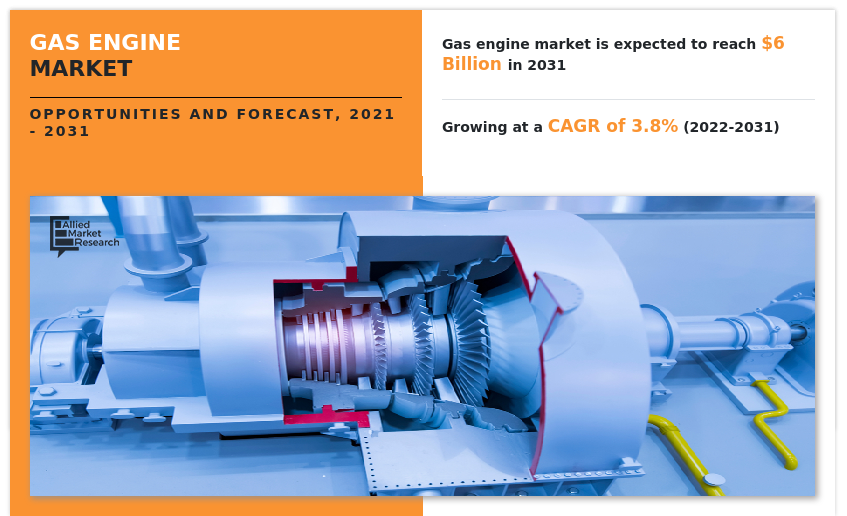
The gas engine market is segmented into Fuel Type, Power Output, Application and End Use.
A gas engine is a reciprocating internal combustion engine, which primarily runs on natural gas and other special gases such as shale gas, mine gas, biogas, landfill gas, sewage gas, and syngas. These engines generally achieve more than 90% efficiency due to their high electrical and thermal efficiency, low operating and service costs, and high reliability. They are used for various applications including power generation, cogeneration, mechanical drive, and tri-generation applications, such as district heating schemes, hospitals, universities, or industrial plants.
The demand for gas engines is experiencing increase in the power generation industry with new emission control regulations. The industrial sector, including chemicals, metals, and manufacturing industries, is a major contributor to the escalating demand for gas engines. The production of natural gas, which is required for the functioning of gas engines, is growing at a significant rate.
Gas engines are less expensive, environmentally friendly, and more reliable and efficient than engines based on other fuel sources. According to Eurostat, natural gas accounts for more than 25% of energy consumption in the U.S. Elevated use in applications such as heating, electricity generation, and vehicle functioning is bolstering the demand for natural gas engines. During the COVID-19 situation, a large part of the population began working from home, virtually attending school from home, and enjoying entertainment at home. Hence, the utility service providers are using gas generators to manage peak loads, to provide a solution for unexpected power outages. Thus, a continuous surge in demand from developing and developed countries is one of the key factors driving the gas engine market growth.
The gas engine market forecast is segmented on the basis of power output, fuel type, application, end use and region. On the basis of power output, it is segmented into 0.5-1MW, 1-2MW, 2-5MW, 5-15MW, and above 15MW. On the basis of fuel type, the market is bifurcated into natural gas, special gas, and others. On the basis of application, the market is divided into power generation, mechanical drive, cogeneration, and others. In addition, on the basis of end use, the global gas engine market is segmented into marine, utilities, oil & gas, manufacturing, and others.
Region wise, the market is studied across North America, Europe, Asia-Pacific, and LAMEA. Presently, North America accounts for the largest gas engine market share, followed by Europe and Asia-Pacific.
The major companies profiled in this report include Cummins Inc., Caterpillar, Mitsubishi Heavy Industries, Ltd., Rolls-Royce plc., Volkswagen AG, Wärtsilä, Kohler Co., Yanmar Co Ltd., Hyundai Heavy Industries Co., Ltd., China Yuchai International Limited, Siemens, Doosan Corporation, Cooper Corp., INNIO, Kawasaki Heavy Industries, Ltd., Man SE, and JFE Engineering Corporation. Rapid development of industrialization, modernization and spread of information through internet led to the development of demand for data centers, heavy manufacturing industries, and light manufacturing industries, which in-turn has fuelled the demand for gas engine. Additional growth strategies such as expansion of production capacities, acquisition, partnership and research & innovation in the gas fired power generation systems has led to attain key developments in the global gas engine market trends.
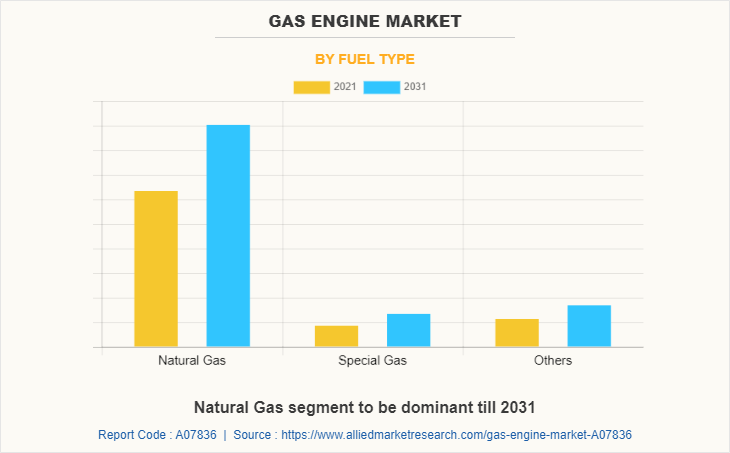
The natural gas segment dominates the global gas engine market. Natural gas is an odorless, gaseous mixture of hydrocarbons, predominantly made up of methane. Gasoline powered vehicles with spark ignited internal combustion engines. The engine functions the same way as a gasoline engine. Natural gas is stored in a fuel tank, or cylinder, typically at the back of the vehicle. Compressed natural gas is used as fuel source for the power generation. The increase in demand for power and the investment of the key players toward low emission and low cost power generation will drive the gas engine market. The advent of gas trading, combined with physical and technical constraints combine to make natural gas prices very volatile in the short-term. Furthermore, the government regulation over the zero-carbon targets by 2050, has led to the growth of the gas engine industry, hence leading the growth of the gas engine market. The presence of above mentioned advantages will drive the growth of the market.
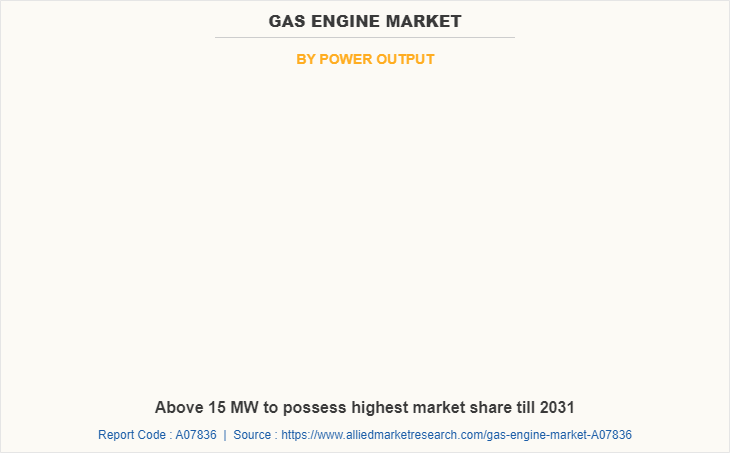
The above 15 MW power output segment dominates the global gas engine market. Above 15 MW power output gas engines are used in marine submarines and warships as a power source to drive these war machines. The increase in demand for this equipment to safeguard the coast line and border among the developing & developed countries are expected to have positive impact on the market. The presence of various advantages of gas engine for the utilization as a drive source for the submarine compared to the conventional engine is driving the growth of the market. Furthermore, increase in fuel efficiency and investment of key players to improve the design of the gas engine are projected to drive the market growth. Increase in utilization of gas engines in the military and marine equipment in order to provide comfortable life for soldiers in border areas is anticipated to provide ample opportunities for the development of the market.
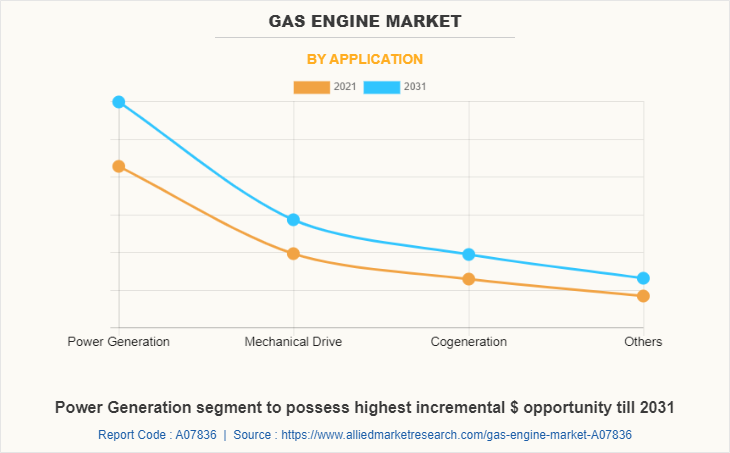
The power generation segment dominates the global gas engine market. Power generation can be defined as the process of transforming various forms of energy into electrical energy. Power is consumed in most modern applications (residential, commercial, and industrial), and in general, the sources for power generation can be categorized into renewable and non-renewable energy. Gas based engines are also used in the power generation; for instance, CNG and LPG are non-renewable energy that are produced from fossil fuel; bio gas is renewable energy which is produced form organic waste. Rise in population across the globe, followed by rapid urbanization in emerging regions, rise in number of consumers has resulted in a steady rise in the electricity demand is a crucial factor driving the growth of the power generation in gas engine market. The increasing demand for smart grids is likely to be another key feature of the development of the power generation across the world over the coming years. Moreover, the increasing government investment in building and maintaining a robust energy infrastructure drove the demand for power generation systems. The surge in demand for power generation systems is expected to provide ample opportunities for the development of the market.
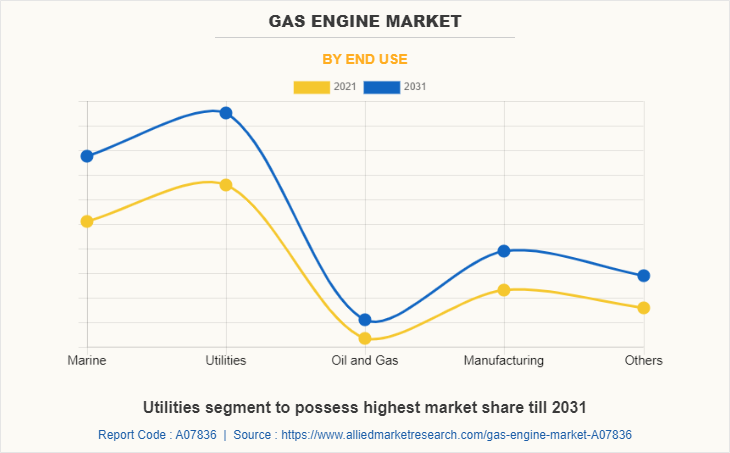
The utilities segment dominates the global gas engine market. Utilities are essential services that play a vital role in economic and social development. Electric utilities can operate gas engine generators continuously to serve base electrical loads. This is particularly advantageous in the absence of a reliable centralized power plant, or where the economics and availability of natural gas fuel are key drivers. Rise in population across the globe, followed by rapid urbanization in emerging regions, rise in number of consumers has resulted in a steady rise in the electricity demand, which is a crucial factor driving the growth of the power generation in gas engine market. The presence of benefits from utility gas fired generators applications such as reduced energy costs, efficient utilization of resources, and increased revenue opportunities, especially in countries where no centralized power grids are available. The surge in the demand for power generation systems and the presence of advantages will provide ample opportunities for the development of the market.
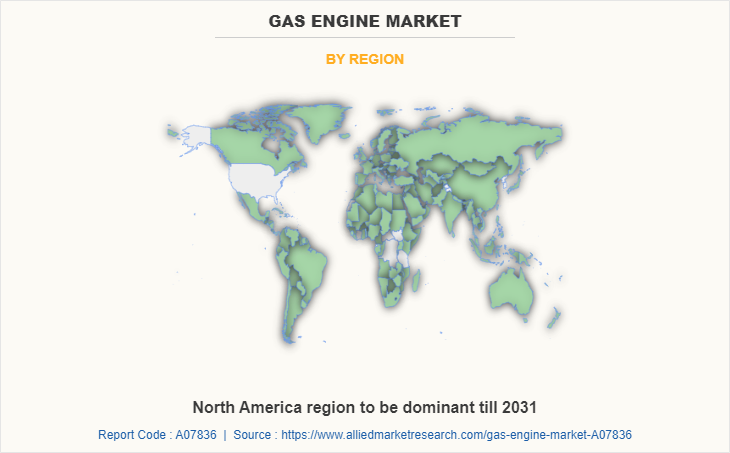
North America is analyzed across the U.S., Canada, and Mexico. U.S. and Canada are the major players in this region. The U.S. government regulations and the utilization of gas engines in the marine and automotive sector are expected to drive the gas engine market. The presence of the winter season has also created the demand for gas engine, owing to increase in demand for combined heat and power systems. The presence of developed countries in this region has led to surge in the construction sector, which propelled the demand for gas engines in the utilities such as grid balancing, and power tools in marine, oil & gas, and manufacturing industry. The boom in the population and immigration in Canada have led to the surge in the residential construction which have positive impact on the gas engine market. Furthermore, the presence of abundant oil & gas resources in Canada region has created the demand for the gas engine. The above mentioned are major factors driving the growth of the market in this region during the forecast period.
COVID-19 analysis:
COVID-19 has severely impacted the global economy with devastating effects on global trade, which has simultaneously affected households, business, financial institution, industrial establishments and infrastructure companies. The novel coronavirus has affected several economies ad caused lockdown in many countries, which has limited the growth of the market. The shutdown of industrial manufacturer led to the decline in the demand for gas engine in most of the countries across the world led to decline in the demand for the gas engine market. The decrease in utilization of power in the industrial facilities across the globe during the outbreak has a negative impact on the development of the market.
In several countries, the renewable sector is mainly dependent on imports from other regions, primarily China. Around 60% of engines and generation sets are produced in the U.S. and are supplied across the globe. Gas based engines project developers worldwide are worried about project delays due to the slowdown of manufacturing in the U.S. Major suppliers are also observing production delays due to COVID-19, thereby causing a huge backlog for fulfilling orders. These factors hampered the growth of the market in the forecast period.
After the global vaccination the government of various countries has taken initiatives to increase the investment in the renewable energy related industries, especially gas fired power systems. Increase in investment is mostly to improve the national energy security during the pandemic and other crisis. The presence of above mentioned activities and change in policies due to outbreak of pandemic have positive impact on the development of the market during the forecast period.
Key Benefits For Stakeholders
- This report provides a quantitative analysis of the market segments, current trends, estimations, and dynamics of the gas engine market analysis from 2021 to 2031 to identify the prevailing gas engine market opportunities.
- The market research is offered along with information related to key drivers, restraints, and opportunities.
- Porter's five forces analysis highlights the potency of buyers and suppliers to enable stakeholders make profit-oriented business decisions and strengthen their supplier-buyer network.
- In-depth analysis of the gas engine market segmentation assists to determine the prevailing market opportunities.
- Major countries in each region are mapped according to their revenue contribution to the global market.
- Market player positioning facilitates benchmarking and provides a clear understanding of the present position of the market players.
- The report includes the analysis of the regional as well as global gas engine market trends, key players, market segments, application areas, and market growth strategies.
Gas Engine Market Report Highlights
| Aspects | Details |
| By Fuel Type |
|
| By Power Output |
|
| By Application |
|
| By End Use |
|
| By Region |
|
| Key Market Players | Cummins Inc., Mitsubishi Heavy Industries, Ltd., Volkswagen AG, Kawasaki Heavy Industries, Ltd., Kohler Co., Cooper Corp., Yanmar Co Ltd., China Yuchai International Limited, JFE Engineering Corporation, Rolls-Royce plc, INNIO, MAN SE, Doosan Corporation, Caterpillar, Wärtsilä, Siemens AG, Hyundai Heavy Industries Co., Ltd. |
Analyst Review
According to CXO Perspective, the global gas engines market is expected to witness increased demand during the forecast period, due to rapidly growing awareness among the people regarding the advantages of the gas powered systems and high efficiency conversion of gas engine.
The rapidly growing investment of individuals toward oil & gas, and manufacturing industries has led to the demand for power tools such as mining, drilling, and other tools. The increase in utilization of the smart devices due to the Internet of Things (IoT) has led to the demand for the datacenters, which in turn boosting the development of the gas engines market.
A gas engine is an internal combustion engine that runs on a gaseous fuel such as coal gas, biogas, landfill gas, or natural gas. The demand for outdoor power equipment is a major factor for the rise in gas engine power tools. Rise in construction of residential and commercial buildings led the homeowners to invest in the gas fired power equipment due to lower costs and less cost of maintenance.
Gas engines have a wide range of applications in heavy manufacturing and light manufacturing industries and portable generators. Surge in demand for mechanical drive and power generation in various industries is one of the factors that are expected to drive the growth of the gas engines market.
The environmental impact of the gas engine and the government regulations toward these tools has led the manufacturer to invest and innovate power tools that are less harmful to the environment. The rapid innovation in alternatives such as electric and renewable-powered tools, is one of the factors hampering the growth of the gas engines market.
Rise in demand for power equipment with low-emission and fuel-efficient and the shift toward the generation of power through gas fire are the key factors boosting the Gas Engines market growth.
Increase in innovation of more efficient gas engines is the Main Driver of Gas Engines Market
Cummins Inc., Caterpillar, Mitsubishi Heavy Industries, Ltd., Rolls-Royce plc, Volkswagen AG, Wärtsilä, Kohler Co., Yanmar Co Ltd., Hyundai Heavy Industries Co., Ltd., China Yuchai International Limited, Siemens, Doosan Corporation, Cooper Corp., INNIO, Kawasaki Heavy Industries, Ltd., Man SE, and JFE Engineering Corporation.
The market value of Gas Engines in 2031 is expected to be $6.0 billion
The global gas engines market is segmented on the basis of by power output, fuel type, application, end use and region. On the basis of power output, it is segmented into 0.5-1MW, 1-2MW, 2-5MW, 5-15MW, and above 15MW. On the basis of fuel type, the market is bifurcated into natural gas, special gas, and others. On the basis of application, the market is bifurcated into power generation, mechanical drive, cogeneration, and others. In addition, on the basis of end use, the global gas engines market is segmented into marine, utilities, oil & gas, manufacturing, and others. Region wise, the market is studied across North America, Europe, Asia-Pacific, and LAMEA.
After the global vaccination the government of various countries has taken initiatives to increase the investment in the renewable energy related industries, especially gas fired power systems. Increase in investment is mostly to improve the national energy security during the pandemic and other crisis. The presence of above mentioned activities and change in policies due to outbreak of pandemic have positive impact on the development of the market during the forecast period.
Utility based application is projected to increase the demand for Gas Engines Market?
Loading Table Of Content...


